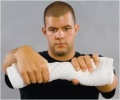Wringing test for lateral epicondylitis: Difference between revisions
Abdul Wajid (talk | contribs) (Created page with "{{subst:Special Test}}") |
Kim Jackson (talk | contribs) m (Text replacement - "{{Special:Contributor/{{FULLPAGENAME}}}}" to "{{Special:Contributors/{{FULLPAGENAME}}}}") |
||
| (18 intermediate revisions by 5 users not shown) | |||
| Line 1: | Line 1: | ||
<div class="editorbox"> | <div class="editorbox">'''Original Editor '''-Abdul Wajid | ||
'''Original Editor '''- | |||
''' | '''Top Contributors''' - {{Special:Contributors/{{FULLPAGENAME}}}} | ||
</div> | </div> | ||
== Purpose | == Purpose == | ||
The Wringing Test is a general screening examination used to detect carpal tunnel syndrome, Lateral epicondylitis or arthropathy.<br> It is a basic test that can help narrow down the focus of a regional examination. | |||
== Technique< | == Technique == | ||
<gallery> | |||
wringing test.jpg | |||
</gallery>Patient should be awake and cooperative when performing the wringing test. | |||
* Patient could be seated or standing during the test. | |||
* Patient wrings a towel or wash cloth. With hands on both ends of the towel, the patient twists it in opposite directions. | |||
* The examiner checks for any numbness, tingling or shooting pain on the wrist or over the elbow area.{{#ev:youtube|https://www.youtube.com/watch?v=oKnhdMDqefY}} | |||
== Interpretation == | |||
== | ===== Positive Wringing Test ===== | ||
# '''Paresthesia''' or the presence of numbness, tingling sensation or shooting electrical pain. This could indicate carpal tunnel syndrome. | |||
# '''Elbow Pain''' could indicate epicondylitis or sprain or strain along the elbow area.<ref>Warren, RF. Tennis elbow (epicondylitis): epidemiology and conservative treatment, in AAOS Symposium and Upper Extremity Injuries in Athletes, Pettrone, F.A., Ed. St. Louis: C.V. Mosby, 1986; 233-243. Level of Evidence: 1B</ref> | |||
# '''Wrist Pain''' could indicate arthropathy or sprain or strain along the wrist area. | |||
== | |||
== References == | == References == | ||
<references /> | <references /> | ||
[[Category:Special_Tests]] | |||
[[Category:Primary Contact]] | |||
[[Category:Sports Medicine]] | |||
[[Category:Athlete Assessment]] | |||
[[Category:Wrist]] | |||
[[Category:Elbow]] | |||
[[Category:Wrist - Special Tests]] | |||
[[Category:Elbow - Special Tests]] | |||
Latest revision as of 21:55, 2 February 2021
Top Contributors - Abdul Wajid, Kim Jackson, George Prudden, Claire Knott and Wanda van Niekerk
Purpose[edit | edit source]
The Wringing Test is a general screening examination used to detect carpal tunnel syndrome, Lateral epicondylitis or arthropathy.
It is a basic test that can help narrow down the focus of a regional examination.
Technique[edit | edit source]
Patient should be awake and cooperative when performing the wringing test.
- Patient could be seated or standing during the test.
- Patient wrings a towel or wash cloth. With hands on both ends of the towel, the patient twists it in opposite directions.
- The examiner checks for any numbness, tingling or shooting pain on the wrist or over the elbow area.
Interpretation[edit | edit source]
Positive Wringing Test[edit | edit source]
- Paresthesia or the presence of numbness, tingling sensation or shooting electrical pain. This could indicate carpal tunnel syndrome.
- Elbow Pain could indicate epicondylitis or sprain or strain along the elbow area.[1]
- Wrist Pain could indicate arthropathy or sprain or strain along the wrist area.
References[edit | edit source]
- ↑ Warren, RF. Tennis elbow (epicondylitis): epidemiology and conservative treatment, in AAOS Symposium and Upper Extremity Injuries in Athletes, Pettrone, F.A., Ed. St. Louis: C.V. Mosby, 1986; 233-243. Level of Evidence: 1B







